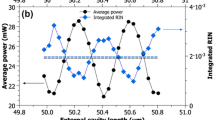Abstract
We extend earlier work on the theory of active mode-locking in a laser with a very long gain recovery time and obtain approximate closed-form solutions. We show how the results can be reduced to the well-known Kuizenga and Siegman formulae in the limit of small modulation depth and large laser bandwidth.
We also discuss the physical relevance of the cavity “supermodes” in determining the stability properties of the mode-locked laser. We show that when the modulation depth is too small or the bandwidth too large, different supermodes have similar energies and we argue that under these circumstances, the laser will not be able to sustain mode-locked operation.
Similar content being viewed by others
References
G.H.C. New, L.A. Zenteno, P.M. Radmore: Opt. Commun.48, 149–154 (1983)
T.J. Nelson. JEEE J. QE-8, 29–33 (1972)
R.S. Putnam: J. Opt. Soc. Am. B1, 771–773 (1984)
D.J. Kuizenga, A.E. Siegman: IEEE J. QE-6, 694–708 (1970)
J.M. Catherall, G.H.C. New, P.M. Radmore: Opt. Lett.7, 319–321 (1982)
M. Piche: Can. J. Phys.61, 725–735 (1983)
H.A. Haus: IEEE J. QE-11, 323–330 (1975)
M. Abramowitz, J.A. Stegun:Handbook of Mathematical Functions (Dover, New York 1965) pp. 726–727
Author information
Authors and Affiliations
Rights and permissions
About this article
Cite this article
Zenteno, L.A., Avramopoulos, H. & New, G.H.C. Detailed analysis of active mode-locking. Appl. Phys. B 40, 141–146 (1986). https://doi.org/10.1007/BF00697243
Received:
Accepted:
Issue Date:
DOI: https://doi.org/10.1007/BF00697243




